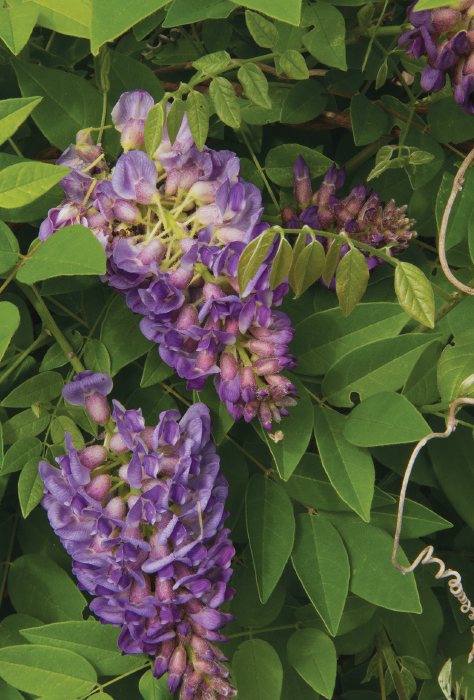In the unofficial spring competition to be the biggest, most bodacious bloomer in the landscape, wisterias often emerge the winner, displaying broad swaths of vines dripping with purple blossoms. Unfortunately, this beaut can be a brute.
The lovely lure of a mature wisteria in bloom is undeniable, but such a sensational show usually comes from either Chinese wisteria (Wisteria sinensis) or Japanese wisteria (W. floribunda), both aggressive vines that can quickly stretch beyond 60 feet.
And, by way of seeds and underground runners, they can also easily escape the garden to overwhelm native habitats, girdling trunks and shading or breaking branches as they spread. Not surprisingly, both have been labeled invasive in the Southeast.
However, there is a way to enjoy wisteria without worrying about it wandering away — consider selections of American wisteria (W. frutescens) or Kentucky wisteria (W. macrostachya), which are both native to this country.
These indigenous alternatives tend to restrain their reach to around 30 feet or shorter and are less inclined to over-propagate and swallow the countryside. Listed below are selections of, to borrow heavily from Bruce Springsteen, wisterias born in the U.S.A. They can be found for sale at local garden shops or on the Web and will accent rather than attack your landscape this spring.
Amethyst Falls. An American wisteria, it is a refined vine that has really caught the attention of Southeast gardeners. Although its bluish-purple flower racemes are a modest (compared to its Asian cousins) 6 inches long and only mildly fragrant, this vine will not keep a homeowner up at night wondering if it has covered the garage yet.
Longwood Purple. As advertised, this American wisteria hails from Longwood Gardens in Pennsylvania. It exhibits deeper purple blooms than ‘Amethyst Falls’ and tends to have bushier foliage. Typical of all wisterias, ‘Longwood Purple’ will flower best in a sunny location.
Blue Moon. A Kentucky wisteria selection, this vine shows off fragrant dangles of blue-violet blossoms that can be up to a foot long. And don’t worry about any wicked winter in this region nailing hardy ‘Blue Moon’; it can take temperatures down to minus 40 degrees!
Nivea. Looking for a divine vine to add to a white garden? The tightly clustered blooms of this American wisteria soften the species’ typical purple blossoms to an elegant white hue. The Kentucky wisteria ‘Clara Mack’ also displays flowers in a lighter shade of pale, but its racemes are longer, stretching up to a foot in length.
L.A. Jackson is the former editor of Carolina Gardener Magazine. Want to ask L.A. a question about your garden? Contact him by email at lajackson1@gmail.com.
To Do in the Garden
March
- Now is a good time to divide and transplant perennials such as astilbes, bleeding hearts, ajuga, oxalis, heuchera, phlox, hostas, liriope, daylilies and shasta daisies. Herbs such as mint, creeping thyme, tarragon and chives can be divided at this time, too.
- If you are preparing garden trellises for annual ornamental and vegetable vine plants this summer, why not add more color and interest to the structures? White string will work as supports for the vines, but so will the colorful yarns that can be found at craft stores.
- Time to wake up the veggie patch. At the beginning of this month, get growing with such cool-season vegetables as lettuce, kale, onions, spinach, potatoes, cabbage, sugar snaps and radishes. Also, the middle of the month is prime planting time for broccoli, cauliflower and Chinese cabbage.
- Remember to buy or build birdhouses made of wood this spring. Compared to metal or plastic, wood is a better insulator, which helps prevent the feathered occupants from overheating during sizzling days.
April
- Remember where you planted your taros, hostas, hardy begonias, Japanese anemones or butterfly weed last year? Don’t be so quick to write them off and find replacements; these shy perennials usually sprout later in the spring.
- Climbing roses don’t really live up to their name. They need to be trained and tied loosely onto supports.
- If azaleas are looking raggedy, wait until after they have finished blooming to trim them into proper shape.
- Whether for the lawn or the garden, when you water, water deeply. Long, thorough waterings encourage roots to penetrate further into the soil, making plants less susceptible to suffering during hot, dry weather.
- Have an old mailbox in the garage? Give it a coat of bright paint and nail it to a post in the garden to store string, plant tags, twist-ties, hand tools and other small backyard-growing essentials.
Timely Tip
Water garden plants will soon shake off their winter hibernation hiatus and stir to life in the warming spring. Are you ready to feed their needs? For the best flower displays from water lily and lotus plants, fertilize them about every three to four weeks.
To make this chore easier, ask the folks at your local friendly garden center for special water lily/lotus fertilizer tablets. Water-loving marginal plants such as rose mallow, cardinal flower, spike rush, dwarf papyrus, colocasia and sweet flag will also put on better shows with light additions of nutrients every five to six weeks.
- War at Your Door
- Save the Train: Remembering the Civil War Battle of Morrisville Station
- Vivian Howard: In her own words
- Recipe: Chef Vivian Howard’s Spring Salad
- Action Packed
- Charity Spotlight: Hope for Haiti Foundation
- Adventure on the Horizon
- Holly Springs’ Big Play
- European Tour
- For the Birds: A New Way to Walk in the Woods
- CM Home Tour: Inside Out Patio
- Spring Fever
- Born in the U.S.A.: Native Wisterias







